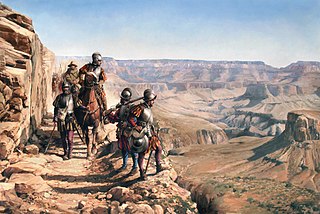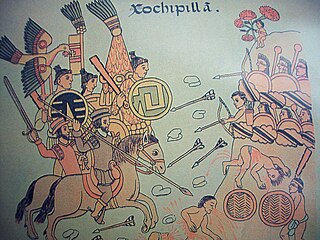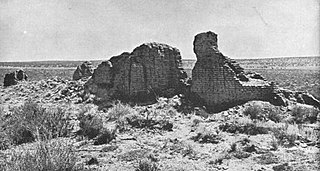Related Research Articles

Francisco Vázquez de Coronado was a Spanish conquistador and explorer who led a large expedition from what is now Mexico to present-day Kansas through parts of the southwestern United States between 1540 and 1542. Vázquez de Coronado had hoped to reach the Cities of Cíbola, often referred to now as the mythical Seven Cities of Gold. His expedition marked the first European sightings of the Grand Canyon and the Colorado River, among other landmarks. His name is often Anglicized as Vasquez de Coronado or just Coronado.

Sinaloa, officially the Estado Libre y Soberano de Sinaloa, is one of the 31 states which, along with Mexico City, comprise the Federal Entities of Mexico. It is divided into 18 municipalities and its capital city is Culiacán Rosales.

Culiacán, officially Culiacán Rosales, is a city in northwestern Mexico, the capital and largest city of both Culiacán Municipality and the state of Sinaloa. The city was founded on 29 September 1531 by the Spanish conquerors Lázaro de Cebreros and Nuño Beltrán de Guzmán under the name "Villa de San Miguel", referring to its patron saint, Michael the Archangel.

The Zuni are Native American Pueblo peoples native to the Zuni River valley. The Zuni people today are federally recognized as the Zuni Tribe of the Zuni Reservation, New Mexico, and most live in the Pueblo of Zuni on the Zuni River, a tributary of the Little Colorado River, in western New Mexico, United States. The Pueblo of Zuni is 55 km (34 mi) south of Gallup, New Mexico. The Zuni tribe lived in multi level adobe houses. In addition to the reservation, the tribe owns trust lands in Catron County, New Mexico, and Apache County, Arizona. The Zuni call their homeland Halona Idiwan’a or Middle Place. The word Zuni is believed to derive from the Western Keres language (Acoma) word sɨ̂‧ni, or a cognate thereof.
Cibola most commonly refers to:

Nuevo Reino de Galicia or simply Nueva Galicia was an autonomous kingdom of the Viceroyalty of New Spain. It was named after Galicia in Spain. Nueva Galicia's territory consisted of the present-day Mexican states of Aguascalientes, Guanajuato, Colima, Jalisco, Nayarit and Zacatecas.

García López de Cárdenas y Figueroa was a Spanish conquistador who was the first European to see the Grand Canyon.
Estevanico, also known as Esteban de Dorantes and Estevanico the Moor, was the first person of African descent to explore North America. Little is known about his background but contemporary accounts described him as a "negro alárabe" or "Arabic-speaking black man" native to Azemmour, Morocco. In 1522, he was sold as a slave to the Spanish nobleman Andrés Dorantes de Carranza in the Portuguese-controlled Moroccan town of Azemmour.

Nuño Beltrán de Guzmán was a Spanish conquistador and colonial administrator in New Spain. He was the governor of the province of Pánuco from 1525 to 1533 and of Nueva Galicia from 1529 to 1534, and president of the first Royal Audiencia of Mexico – the high court that governed New Spain – from 1528 to 1530. He founded several cities in Northwestern Mexico, including Guadalajara.
Marcos de Niza, OFM was a Franciscan friar and missionary from the city of Nice in the Duchy of Savoy. Marcos led the first Spanish expedition to explore what is now the American Southwest. His report of finding a "beautiful city", "more extensive than that of Mexico [City]", induced Viceroy Antonio de Mendoza to organize a large-scale entrada under the leadership of Francisco Vázquez de Coronado. Marcos served as a guide for this expedition but when they failed to find the wealth they expected, Coronado blamed Marcos, called him a liar and sent the friar back to Mexico in disgrace.

The Mixtón War (1540-1542) was a rebellion by the Caxcan people of northwestern Mexico against the Spanish conquerors. The war was named after Mixtón, a hill in Zacatecas which served as an Indigenous stronghold.

Hawikuh, was one of the largest of the Zuni pueblos at the time of the Spanish entrada. It was founded around 1400 AD. It was the first pueblo to be visited and conquered by Spanish explorers. The Spanish chroniclers referred to it as Cevola, Tzibola, or Cibola.
Cristóbal de Oñate was a Spanish Basque explorer, conquistador and colonial official in New Spain. He is considered the founder of the contemporary city of Guadalajara in 1531, as well as other places in Nueva Galicia.
The Real Audiencia of Mexico or Royal Audiencia of Mexico was the highest tribunal of the Spanish crown in the Kingdom of New Spain. The Audiencia was created by royal decree on December 13, 1527, and was seated in the viceregal capital of Mexico City. The First Audiencia was dissolved by the crown for its bungling and corruption and the crown established the Second Audiencia in 1530. This was supplanted by the Viceroyalty of New Spain in 1535. A new Audiencia was created in Guadalajara in western Mexico in 1548.

The Zuni-Cibola Complex is a collection of prehistoric and historic archaeological sites on the Zuni Pueblo in western New Mexico. It comprises Hawikuh, Yellow House, Kechipbowa, and Great Kivas, all sites of long residence and important in the early Spanish colonial contact period. It was declared a National Historic Landmark District in 1974. These properties were considered as major elements of a national park, but the proposal was ultimately rejected by the Zuni people.
The Real Audiencia of Guadalajara, was the highest tribunal of the Spanish crown in what is today northern Mexico and the southwestern United States in the Viceroyalty of New Spain. It was created by royal decree on February 13, 1548, and was originally located in Compostela and permanently seated in Guadalajara in 1560. Its president was the chief political and executive officer of the district, subordinated only to the Viceroy.

Francisco Tenamaztle, also Tenamaxtlan, Tenamaxtli or Tenamaxtle, was a leader of the Caxcan indigenous peoples in Mexico during the Mixtón War of 1540–1542. He was later put on trial in Spain. With the support of Bartolomé de las Casas he defended the justice of his cause by appealing to King Carlos I.

The myth of the Seven Cities of Gold, also known as the Seven Cities of Cíbola, was popular in the 16th century and later featured in several works of popular culture. According to legend, the seven cities of gold referred to Aztec mythology revolving around the Pueblos of the Spanish Nuevo México, today's New Mexico and Southwestern United States.

Municipality of Badiraguato is a municipality in the Mexican state of Sinaloa in northwestern Mexico. The seat of the municipality is in the small town of Badiraguato.
Alonso del Castillo Maldonado was an early Spanish explorer in the Americas. He was one of the last four survivors of the Pánfilo de Narváez expedition, along with Álvar Núñez Cabeza de Vaca, Andrés Dorantes de Carranza and his African slave Estevanico. They were the early non-native people to travel and be enslaved in the Southwest region of the modern United States. Castillo Maldonado lived with a Native American tribe in Texas in 1527 and 1528.
References
- ↑ Linda L. Stampoulos, Linda S. Stampoulos (2008). Postcards of America: Visiting the Grand Canyon. Arcadia Publishing. ISBN 9780738570570.
- 1 2 3 4 5 6 Richard Flint (2013). Great Cruelties Have Been Reported: The 1544 Investigation of the Coronado Expedition. University of New Mexico Press. pp. 416–417. ISBN 9780826353276.
- 1 2 3 Calvin A. Roberts, Susan A. Roberts (1998). A History of New Mexico. University of New Mexico Press. p. 91. ISBN 9780826335081.
- 1 2 3 Matthew Sakiestewa Gilbert (2010). Education Beyond the Mesas: Hopi Students at Sherman Institute, 1902-1929. University of Nebraska Press. pp. 1, 2. ISBN 978-0803234444.
- 1 2 Rebecca A. Carte (2015). Capturing the Landscape of New Spain: Baltasar Obregón and the 1564 Ibarra Expedition. The University of Arizona Press. p. 111. ISBN 9780816531424.
- ↑ G. Saravia, Atanasio (1993). Obras II: Apuntes para la Historia de la Nueva Vizcaya. Universidad Nacional Autónoma de México. ISBN 9789685829090.
- ↑ Locke, Raymond Friday (2002). The Book of the Navajo (6th ed.). Mankind Publishing Company. p. 140. ISBN 978-0876875001.
- ↑ Ward, Greg (2003). The Rough Guide to the Grand Canyon. University of New Mexico Press. p. 56. ISBN 9781843530527.